Attached files
| file | filename |
|---|---|
| 8-K - FORM 8-K - C&J Energy Services, Inc. | d372225d8k.htm |

1 Exhibit 99.1
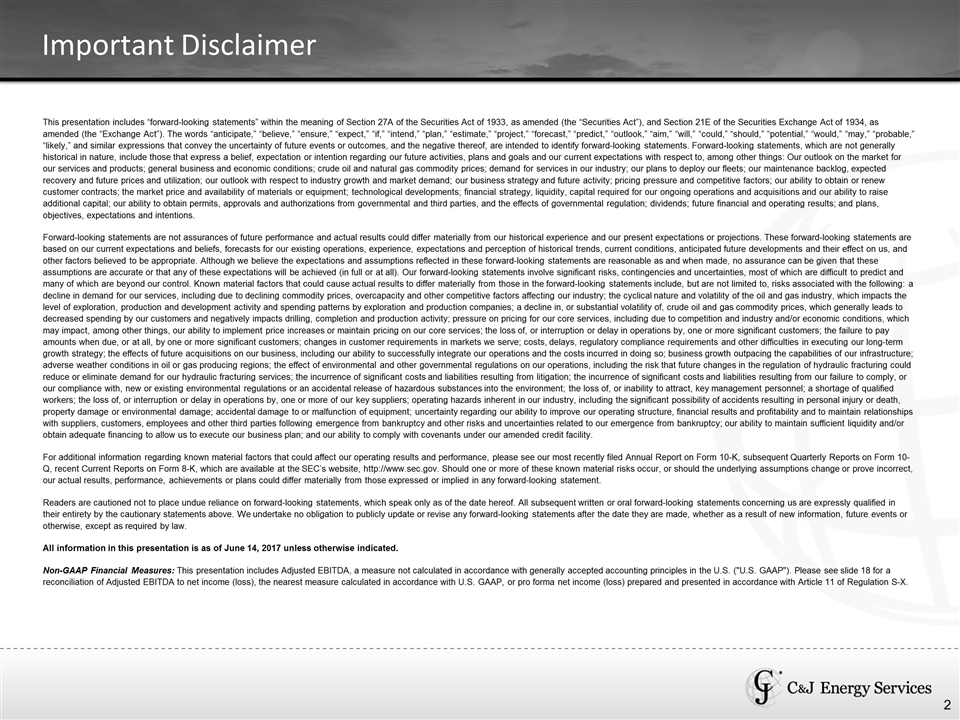
Important Disclaimer This presentation includes “forward-looking statements” within the meaning of Section 27A of the Securities Act of 1933, as amended (the “Securities Act”), and Section 21E of the Securities Exchange Act of 1934, as amended (the “Exchange Act”). The words “anticipate,” “believe,” “ensure,” “expect,” “if,” “intend,” “plan,” “estimate,” “project,” “forecast,” “predict,” “outlook,” “aim,” “will,” “could,” “should,” “potential,” “would,” “may,” “probable,” “likely,” and similar expressions that convey the uncertainty of future events or outcomes, and the negative thereof, are intended to identify forward-looking statements. Forward-looking statements, which are not generally historical in nature, include those that express a belief, expectation or intention regarding our future activities, plans and goals and our current expectations with respect to, among other things: Our outlook on the market for our services and products; general business and economic conditions; crude oil and natural gas commodity prices; demand for services in our industry; our plans to deploy our fleets; our maintenance backlog, expected recovery and future prices and utilization; our outlook with respect to industry growth and market demand; our business strategy and future activity; pricing pressure and competitive factors; our ability to obtain or renew customer contracts; the market price and availability of materials or equipment; technological developments; financial strategy, liquidity, capital required for our ongoing operations and acquisitions and our ability to raise additional capital; our ability to obtain permits, approvals and authorizations from governmental and third parties, and the effects of governmental regulation; dividends; future financial and operating results; and plans, objectives, expectations and intentions. Forward-looking statements are not assurances of future performance and actual results could differ materially from our historical experience and our present expectations or projections. These forward-looking statements are based on our current expectations and beliefs, forecasts for our existing operations, experience, expectations and perception of historical trends, current conditions, anticipated future developments and their effect on us, and other factors believed to be appropriate. Although we believe the expectations and assumptions reflected in these forward-looking statements are reasonable as and when made, no assurance can be given that these assumptions are accurate or that any of these expectations will be achieved (in full or at all). Our forward-looking statements involve significant risks, contingencies and uncertainties, most of which are difficult to predict and many of which are beyond our control. Known material factors that could cause actual results to differ materially from those in the forward-looking statements include, but are not limited to, risks associated with the following: a decline in demand for our services, including due to declining commodity prices, overcapacity and other competitive factors affecting our industry; the cyclical nature and volatility of the oil and gas industry, which impacts the level of exploration, production and development activity and spending patterns by exploration and production companies; a decline in, or substantial volatility of, crude oil and gas commodity prices, which generally leads to decreased spending by our customers and negatively impacts drilling, completion and production activity; pressure on pricing for our core services, including due to competition and industry and/or economic conditions, which may impact, among other things, our ability to implement price increases or maintain pricing on our core services; the loss of, or interruption or delay in operations by, one or more significant customers; the failure to pay amounts when due, or at all, by one or more significant customers; changes in customer requirements in markets we serve; costs, delays, regulatory compliance requirements and other difficulties in executing our long-term growth strategy; the effects of future acquisitions on our business, including our ability to successfully integrate our operations and the costs incurred in doing so; business growth outpacing the capabilities of our infrastructure; adverse weather conditions in oil or gas producing regions; the effect of environmental and other governmental regulations on our operations, including the risk that future changes in the regulation of hydraulic fracturing could reduce or eliminate demand for our hydraulic fracturing services; the incurrence of significant costs and liabilities resulting from litigation; the incurrence of significant costs and liabilities resulting from our failure to comply, or our compliance with, new or existing environmental regulations or an accidental release of hazardous substances into the environment; the loss of, or inability to attract, key management personnel; a shortage of qualified workers; the loss of, or interruption or delay in operations by, one or more of our key suppliers; operating hazards inherent in our industry, including the significant possibility of accidents resulting in personal injury or death, property damage or environmental damage; accidental damage to or malfunction of equipment; uncertainty regarding our ability to improve our operating structure, financial results and profitability and to maintain relationships with suppliers, customers, employees and other third parties following emergence from bankruptcy and other risks and uncertainties related to our emergence from bankruptcy; our ability to maintain sufficient liquidity and/or obtain adequate financing to allow us to execute our business plan; and our ability to comply with covenants under our amended credit facility. For additional information regarding known material factors that could affect our operating results and performance, please see our most recently filed Annual Report on Form 10-K, subsequent Quarterly Reports on Form 10-Q, recent Current Reports on Form 8-K, which are available at the SEC’s website, http://www.sec.gov. Should one or more of these known material risks occur, or should the underlying assumptions change or prove incorrect, our actual results, performance, achievements or plans could differ materially from those expressed or implied in any forward-looking statement. Readers are cautioned not to place undue reliance on forward-looking statements, which speak only as of the date hereof. All subsequent written or oral forward-looking statements concerning us are expressly qualified in their entirety by the cautionary statements above. We undertake no obligation to publicly update or revise any forward-looking statements after the date they are made, whether as a result of new information, future events or otherwise, except as required by law. All information in this presentation is as of June 14, 2017 unless otherwise indicated. Non-GAAP Financial Measures: This presentation includes Adjusted EBITDA, a measure not calculated in accordance with generally accepted accounting principles in the U.S. ("U.S. GAAP"). Please see slide 18 for a reconciliation of Adjusted EBITDA to net income (loss), the nearest measure calculated in accordance with U.S. GAAP, or pro forma net income (loss) prepared and presented in accordance with Article 11 of Regulation S-X. 2

Market Summary 3 Data as of (6/14/2017) Ticker (NYSE) CJ Share Price $34.45 Diluted Shares Outstanding (MM) (1) 63.3 Market Capitalization ($MM) $2,180.7 (1) As of June 14, 2017. Diluted shares outstanding excludes the following: 7,041,638 shares of common stock authorized for issuance as equity awards under the 2017 C&J Energy Services, Inc. Management Incentive Plan (“MIP”). Shares of common stock issuable upon the exercise of 255,570 outstanding stock options issued under the MIP. Shares of common stock issuable upon the exercise of 1,174,344 outstanding warrants issued to legacy C&J stockholders upon emergence from Chapter 11. Shares of common stock issuable upon the exercise of 2,360,166 warrants to be issued to the unsecured claims representative for the benefit of the general unsecured creditors pursuant to the terms of the Restructuring Plan in exchange for the final settlement of all such general unsecured claims.
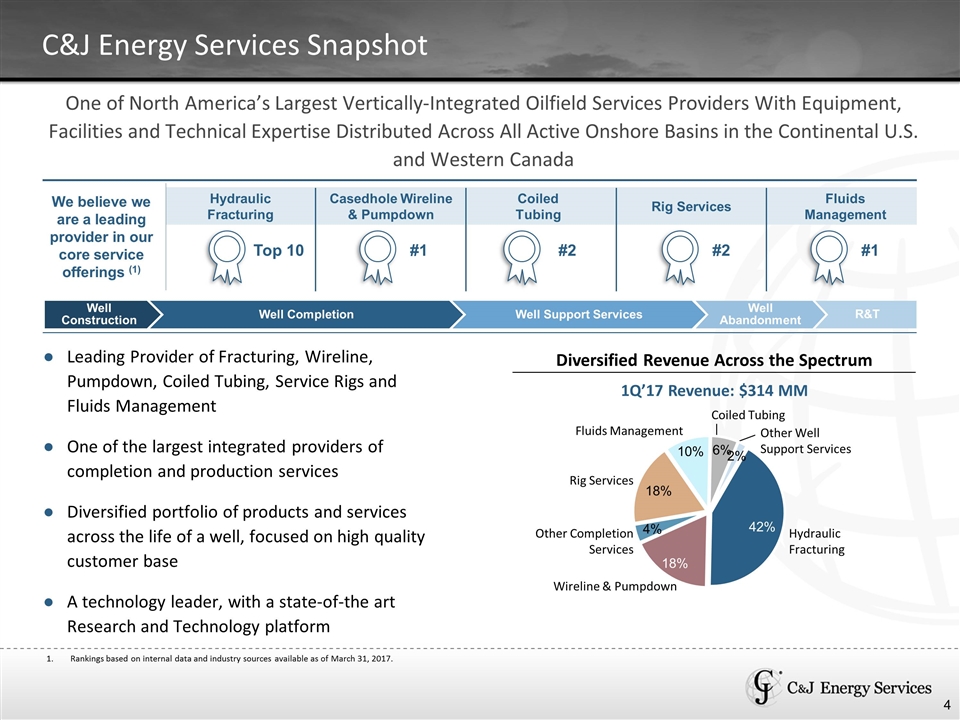
C&J Energy Services Snapshot One of North America’s Largest Vertically-Integrated Oilfield Services Providers With Equipment, Facilities and Technical Expertise Distributed Across All Active Onshore Basins in the Continental U.S. and Western Canada Key Differentiators We believe we are a leading provider in our core service offerings (1) Hydraulic Fracturing Casedhole Wireline & Pumpdown Coiled Tubing Rig Services Fluids Management Top 10 #1 #2 #2 #1 Well Construction Well Completion Well Support Services Well Abandonment Leading Provider of Fracturing, Wireline, Pumpdown, Coiled Tubing, Service Rigs and Fluids Management One of the largest integrated providers of completion and production services Diversified portfolio of products and services across the life of a well, focused on high quality customer base A technology leader, with a state-of-the art Research and Technology platform Diversified Revenue Across the Spectrum Hydraulic Fracturing Other Well Support Services Coiled Tubing Fluids Management Wireline & Pumpdown Other Completion Services Rig Services 1Q’17 Revenue: $314 MM Rankings based on internal data and industry sources available as of March 31, 2017. R&T 7
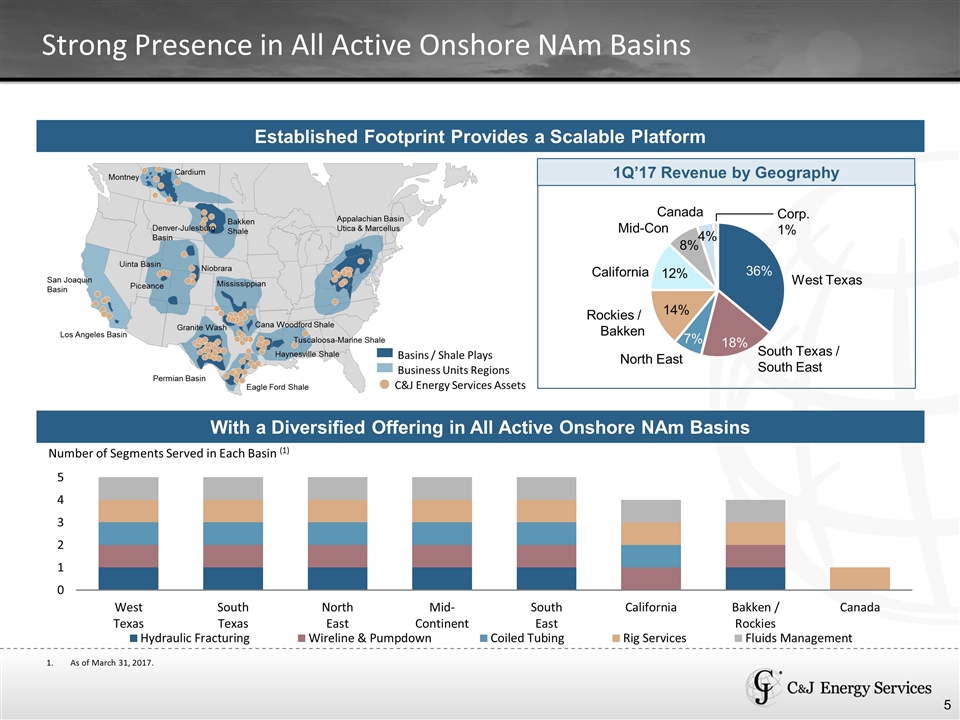
Strong Presence in All Active Onshore NAm Basins Tuscaloosa-Marine Shale Haynesville Shale Eagle Ford Shale Cana Woodford Shale Permian Basin Granite Wash Mississippian Niobrara Los Angeles Basin San Joaquin Basin Piceance Uinta Basin Denver-Julesburg Basin Bakken Shale Cardium Montney Appalachian Basin Utica & Marcellus Basins / Shale Plays Business Units Regions C&J Energy Services Assets West Texas South Texas / South East North East Rockies / Bakken California Mid-Con Canada Corp. 1% Number of Segments Served in Each Basin (1) Established Footprint Provides a Scalable Platform With a Diversified Offering in All Active Onshore NAm Basins 1Q’17 Revenue by Geography 8 As of March 31, 2017.
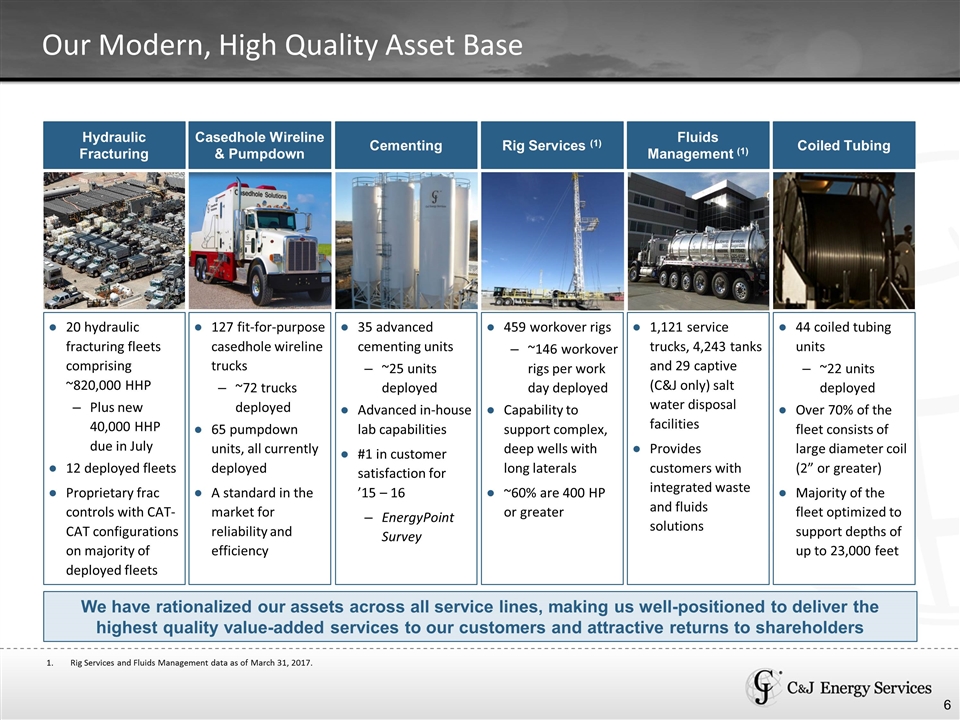
Our Modern, High Quality Asset Base We have rationalized our assets across all service lines, making us well-positioned to deliver the highest quality value-added services to our customers and attractive returns to shareholders Hydraulic Fracturing Casedhole Wireline & Pumpdown Cementing Rig Services (1) Fluids Management (1) Coiled Tubing 20 hydraulic fracturing fleets comprising ~820,000 HHP Plus new 40,000 HHP due in July 12 deployed fleets Proprietary frac controls with CAT-CAT configurations on majority of deployed fleets 127 fit-for-purpose casedhole wireline trucks ~72 trucks deployed 65 pumpdown units, all currently deployed A standard in the market for reliability and efficiency 35 advanced cementing units ~25 units deployed Advanced in-house lab capabilities #1 in customer satisfaction for ’15 – 16 EnergyPoint Survey 459 workover rigs ~146 workover rigs per work day deployed Capability to support complex, deep wells with long laterals ~60% are 400 HP or greater 1,121 service trucks, 4,243 tanks and 29 captive (C&J only) salt water disposal facilities Provides customers with integrated waste and fluids solutions 44 coiled tubing units ~22 units deployed Over 70% of the fleet consists of large diameter coil (2” or greater) Majority of the fleet optimized to support depths of up to 23,000 feet 9 Rig Services and Fluids Management data as of March 31, 2017.
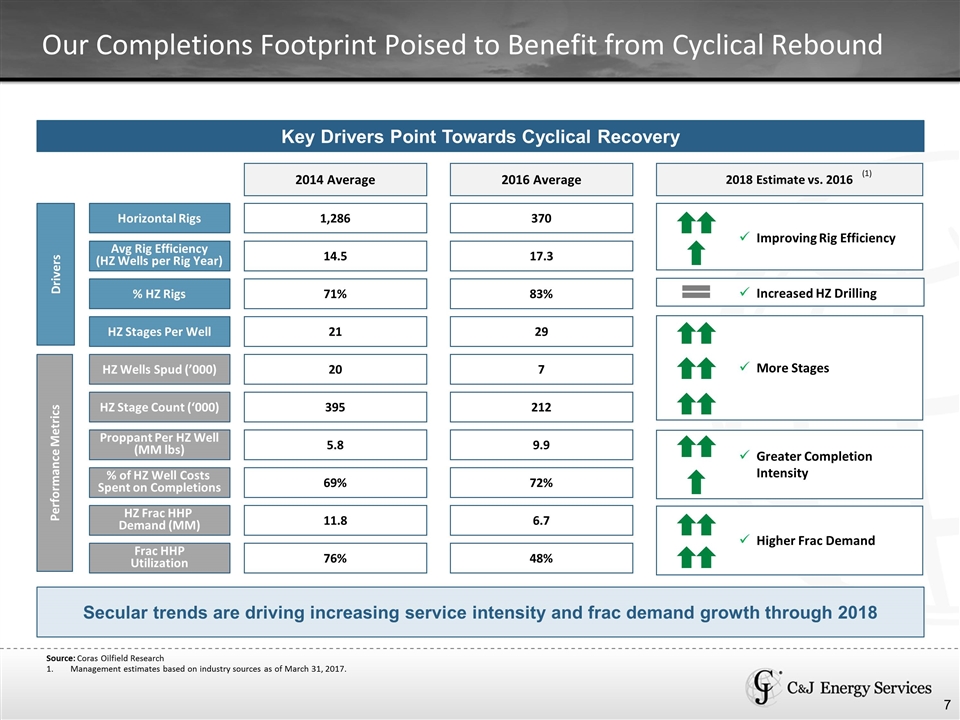
Our Completions Footprint Poised to Benefit from Cyclical Rebound Horizontal Rigs % HZ Rigs Avg Rig Efficiency (HZ Wells per Rig Year) HZ Wells Spud (’000) HZ Stage Count (‘000) HZ Stages Per Well HZ Frac HHP Demand (MM) 2014 Average 2016 Average 2018 Estimate vs. 2016 370 1,286 83% 71% 17.3 14.5 7 20 212 395 29 21 6.7 11.8 Frac HHP Utilization 48% 76% Drivers Performance Metrics Improving Rig Efficiency Higher Frac Demand (1) % of HZ Well Costs Spent on Completions 72% 69% Greater Completion Intensity More Stages Increased HZ Drilling Secular trends are driving increasing service intensity and frac demand growth through 2018 Source: Coras Oilfield Research Management estimates based on industry sources as of March 31, 2017. Key Drivers Point Towards Cyclical Recovery Proppant Per HZ Well (MM lbs) 9.9 5.8 11
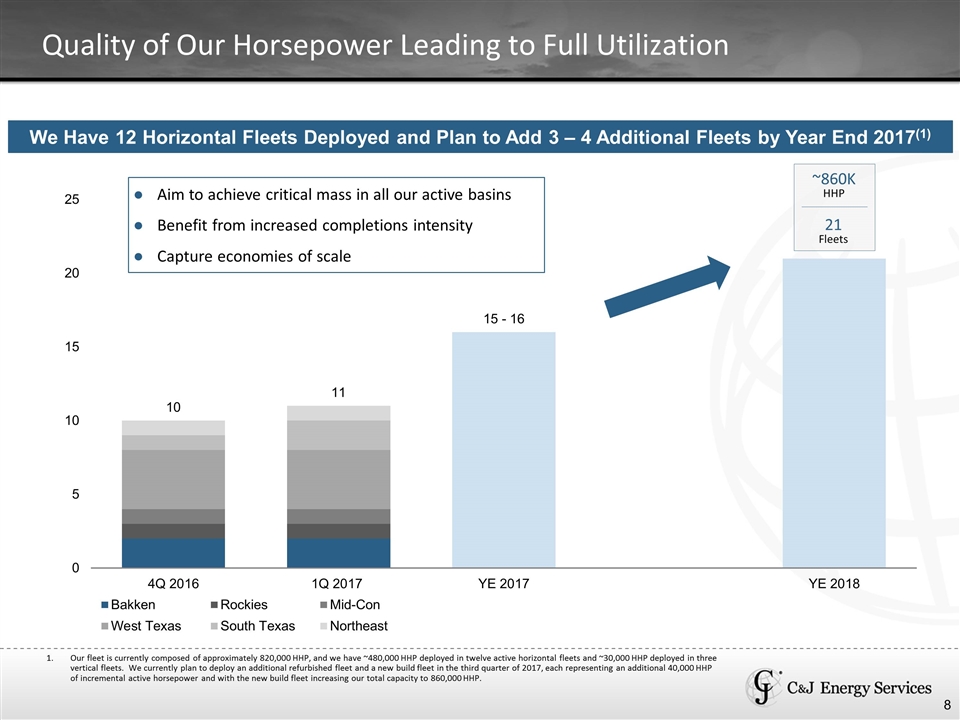
Quality of Our Horsepower Leading to Full Utilization We Have 12 Horizontal Fleets Deployed and Plan to Add 3 – 4 Additional Fleets by Year End 2017(1) Efficiency Trends Increase Frac Earnings Potential Illustrative Per Fleet Metrics 2015 Current Stages per Year 925 1,250 Revenue per Stage ($000’s) $50 $50 Revenue ($MM) 46 63 Gross Profit ($MM) 7 16 % Margin (1) 15% 25% Efficiency Drives Profit Improvement 125% Pricing increases provide a direct $ for $ impact to gross profit 12 ~860K HHP 21 Fleets Aim to achieve critical mass in all our active basins Benefit from increased completions intensity Capture economies of scale Our fleet is currently composed of approximately 820,000 HHP, and we have ~480,000 HHP deployed in twelve active horizontal fleets and ~30,000 HHP deployed in three vertical fleets. We currently plan to deploy an additional refurbished fleet and a new build fleet in the third quarter of 2017, each representing an additional 40,000 HHP of incremental active horsepower and with the new build fleet increasing our total capacity to 860,000 HHP.
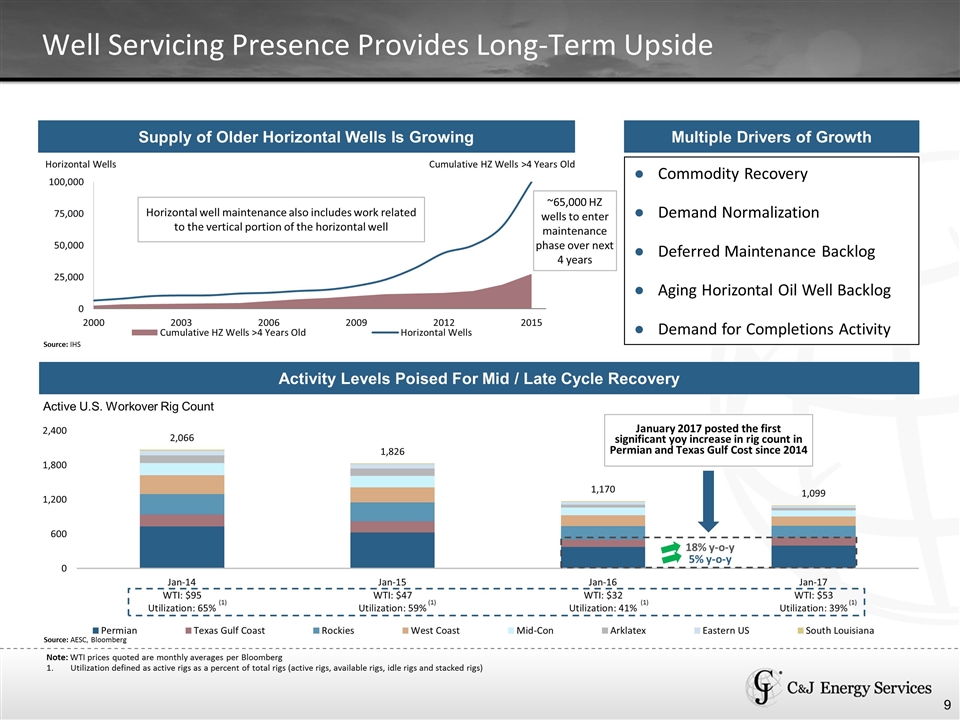
Horizontal Wells Supply of Older Horizontal Wells Is Growing Note: WTI prices quoted are monthly averages per Bloomberg Utilization defined as active rigs as a percent of total rigs (active rigs, available rigs, idle rigs and stacked rigs) Well Servicing Presence Provides Long-Term Upside Cumulative HZ Wells >4 Years Old ~65,000 HZ wells to enter maintenance phase over next 4 years Horizontal well maintenance also includes work related to the vertical portion of the horizontal well Active U.S. Workover Rig Count Activity Levels Poised For Mid / Late Cycle Recovery Source: IHS January 2017 posted the first significant yoy increase in rig count in Permian and Texas Gulf Cost since 2014 18% y-o-y 5% y-o-y Source: AESC, Bloomberg Commodity Recovery Deferred Maintenance Backlog Demand Normalization Demand for Completions Activity Aging Horizontal Oil Well Backlog Multiple Drivers of Growth Commodity Recovery Demand Normalization Deferred Maintenance Backlog Aging Horizontal Oil Well Backlog Demand for Completions Activity (1) (1) (1) (1) 13

A Leading Provider of Service Rigs in the Market Rig classifications: Class 1: 100-199 HP, Class 2: 200-299 HP, Class 3: 300-399, Class 4: 400-499 HP, Class 5: 500+ HP Our High Spec Well Servicing Rig Fleet Is Well Positioned Premium Equipment Optimized For High Spec Services (1) # ~60% of Service Rigs are Class 4 or better 459 Total Service Rigs 275 Capable of HZ Services 2nd largest well service rig business in NAm ~60% class 4+ rigs capable of the most complex jobs Top 10 customers are majors and large independents 300+ customers served in 2016 Strong operating presence in California, Rockies, Permian, South Texas and Western Canada Attract new customers due to our culture of service quality and safety AESC 2016 Gold Safety Award Significant Scale Diversified Footprint Premium Provider Loyal Customers Maintained positive adjusted EBITDA across market cycles Limited capital investment needed to drive cash flow improvement Attractive Financial Returns 14 As of March 31, 2017.
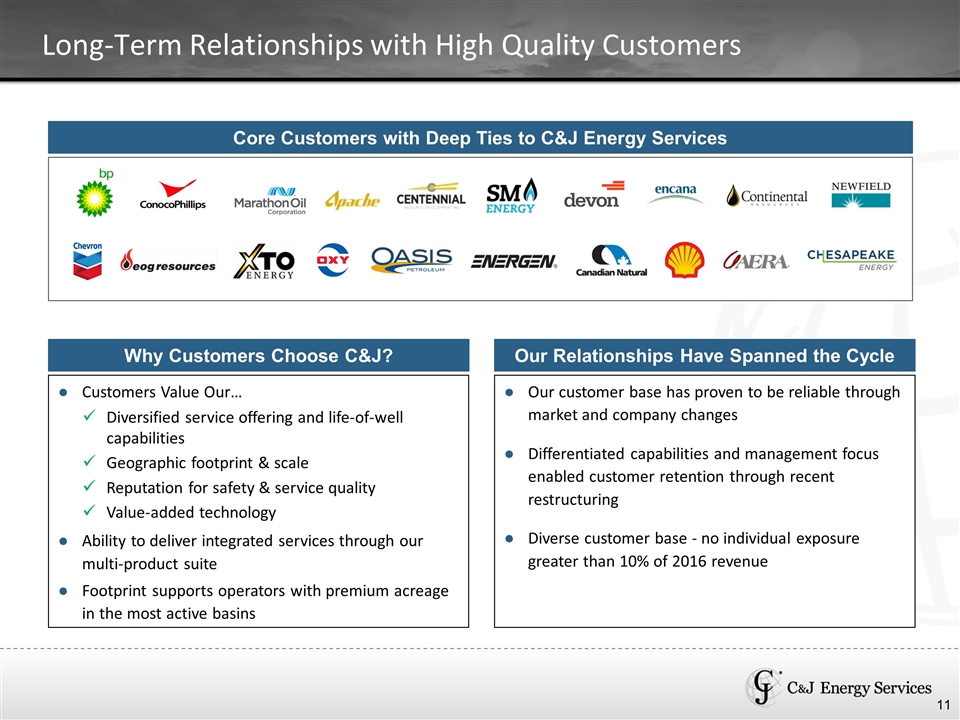
Long-Term Relationships with High Quality Customers Why Customers Choose C&J? Customers Value Our… Ability to deliver integrated services through our multi-product suite Footprint supports operators with premium acreage in the most active basins Our Relationships Have Spanned the Cycle Our customer base has proven to be reliable through market and company changes Differentiated capabilities and management focus enabled customer retention through recent restructuring Diverse customer base - no individual exposure greater than 10% of 2016 revenue Logos from next few pages Core Customers with Deep Ties to C&J Energy Services Diversified service offering and life-of-well capabilities Geographic footprint & scale Reputation for safety & service quality Value-added technology 15
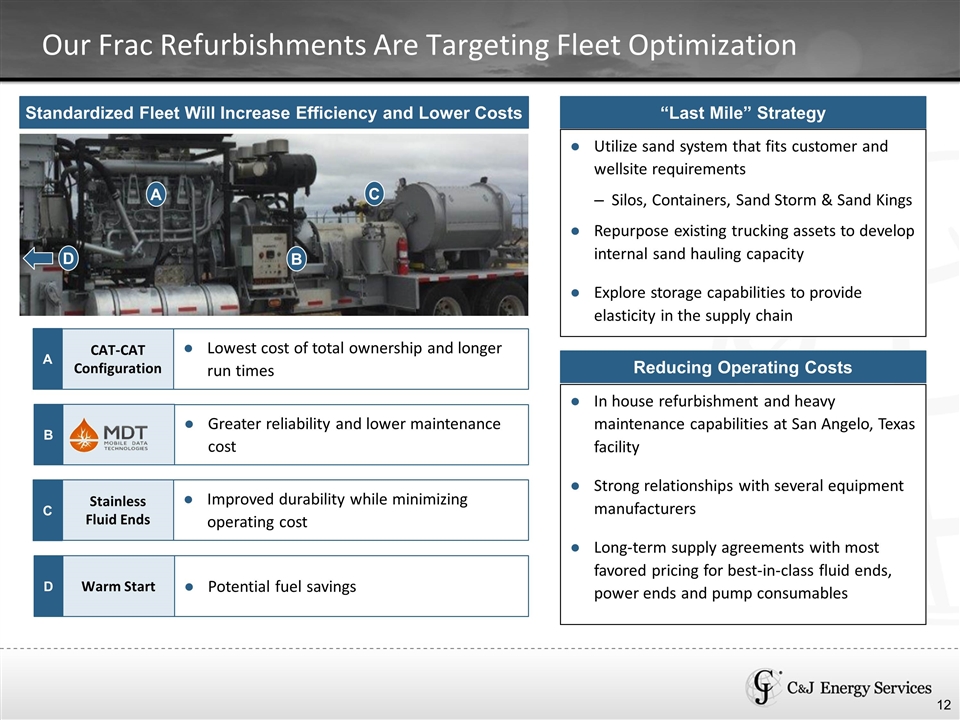
Our Frac Refurbishments Are Targeting Fleet Optimization Standardized Fleet Will Increase Efficiency and Lower Costs B C A D CAT-CAT Configuration A Lowest cost of total ownership and longer run times Warm Start D Potential fuel savings Stainless Fluid Ends C Improved durability while minimizing operating cost B Greater reliability and lower maintenance cost 17 “Last Mile” Strategy Reducing Operating Costs In house refurbishment and heavy maintenance capabilities at San Angelo, Texas facility Strong relationships with several equipment manufacturers Long-term supply agreements with most favored pricing for best-in-class fluid ends, power ends and pump consumables Utilize sand system that fits customer and wellsite requirements Silos, Containers, Sand Storm & Sand Kings Repurpose existing trucking assets to develop internal sand hauling capacity Explore storage capabilities to provide elasticity in the supply chain

Our Evolutionary Technology Advantage Our R&T Platform and Capabilities Separate C&J from Other Small & Mid Cap Peers Team of 25 engineers and 75 technicians dedicated to solving the most difficult well site challenges R&T Portfolio Drives Increased Returns Perforating Guns Tension Tool Perforating Switches & Accessories Artificial Lift Frac Plugs Frac Controls Frac Chemistry Drilling Tools Just In Time Perforating Smart Drilling Tools Lateral Science Operational Efficiency Cost Reduction New Business Treating Iron Maintenance Frac Pump Warm Start Release Tool Operational Efficiency New Business Perforating Guns & Accessories Mobile Data Technologies (MDT™) Cost Reduction Lateral Science™ One of the lowest cost producers of perforating guns in the industry At least 20 - 30% savings over 3rd party on switches and accessories Engineered solution that improves the frac design and overall well production Over 320 wells analyzed to date Proved to increase production per lateral foot and per pound of proppant Costs ~50% less than competing systems Total fleet synchronization improves automation and efficiency (trade secret) (patent pending) 19
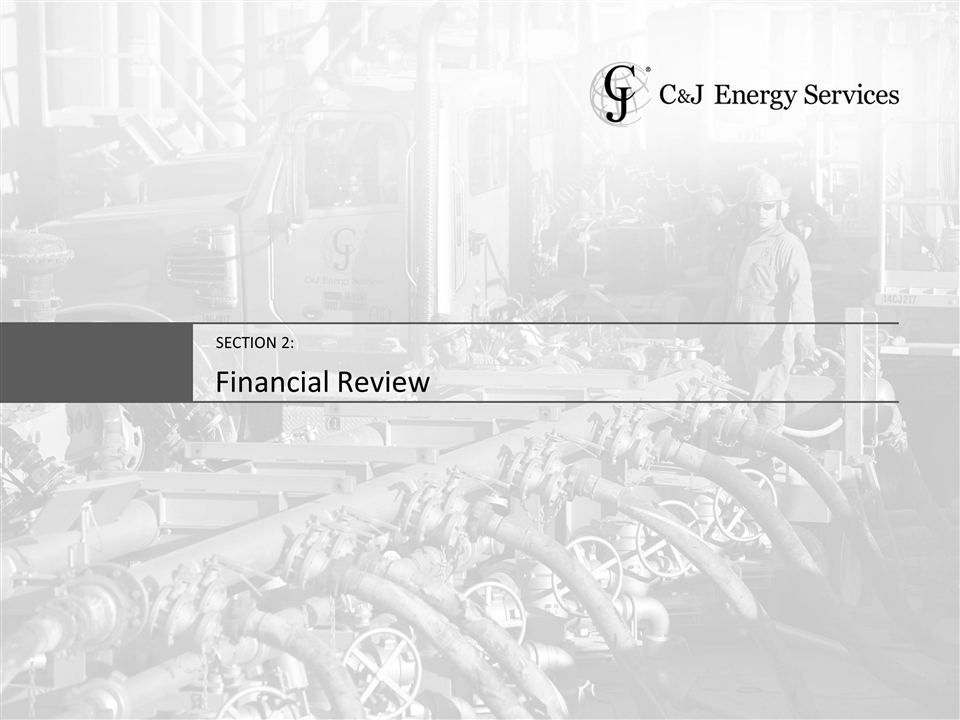
Financial Review Section 2: 21
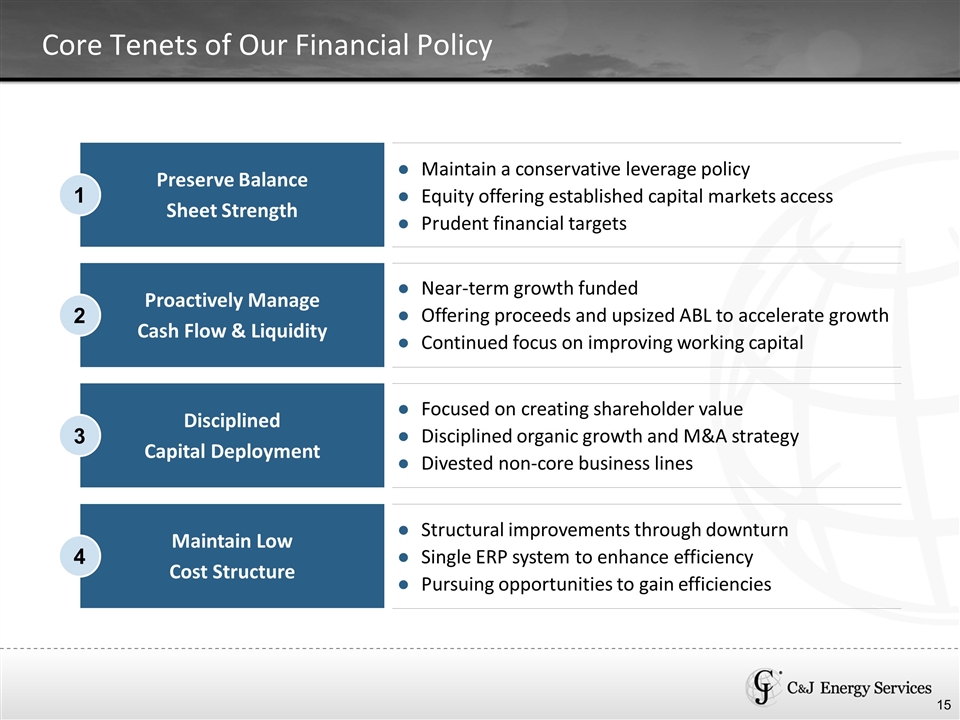
Core Tenets of Our Financial Policy Maintain a conservative leverage policy Equity offering established capital markets access Prudent financial targets Preserve Balance Sheet Strength 1 Near-term growth funded Offering proceeds and upsized ABL to accelerate growth Continued focus on improving working capital Proactively Manage Cash Flow & Liquidity 2 Focused on creating shareholder value Disciplined organic growth and M&A strategy Divested non-core business lines Disciplined Capital Deployment 3 Structural improvements through downturn Single ERP system to enhance efficiency Pursuing opportunities to gain efficiencies Maintain Low Cost Structure 4 22
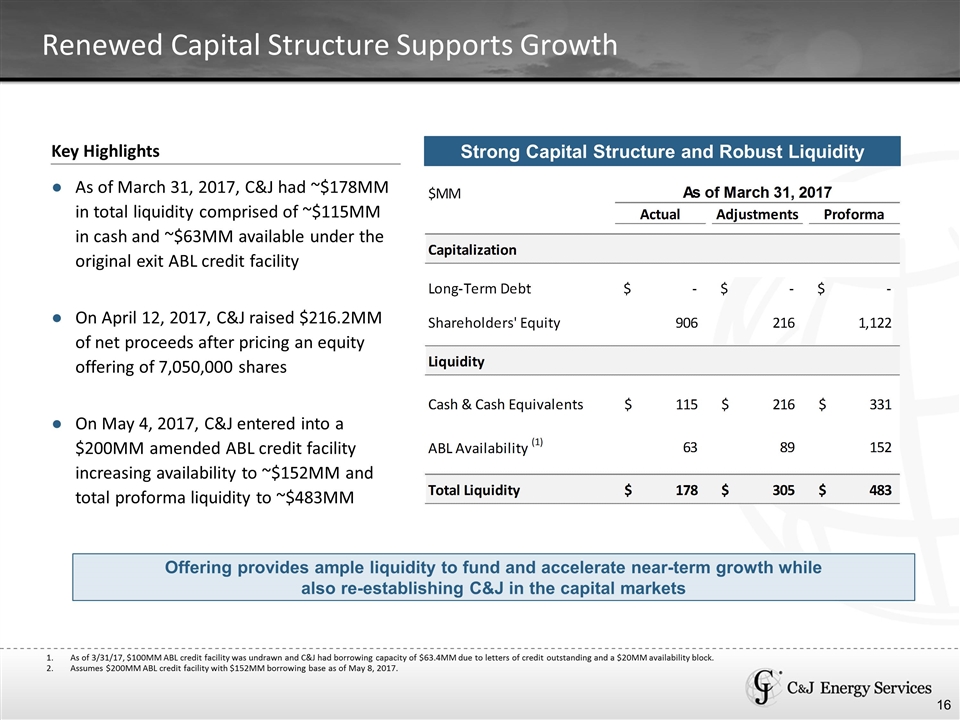
Renewed Capital Structure Supports Growth As of 3/31/17, $100MM ABL credit facility was undrawn and C&J had borrowing capacity of $63.4MM due to letters of credit outstanding and a $20MM availability block. Assumes $200MM ABL credit facility with $152MM borrowing base as of May 8, 2017. Key Highlights As of March 31, 2017, C&J had ~$178MM in total liquidity comprised of ~$115MM in cash and ~$63MM available under the original exit ABL credit facility On April 12, 2017, C&J raised $216.2MM of net proceeds after pricing an equity offering of 7,050,000 shares On May 4, 2017, C&J entered into a $200MM amended ABL credit facility increasing availability to ~$152MM and total proforma liquidity to ~$483MM Strong Capital Structure and Robust Liquidity Offering provides ample liquidity to fund and accelerate near-term growth while also re-establishing C&J in the capital markets 24 (2)
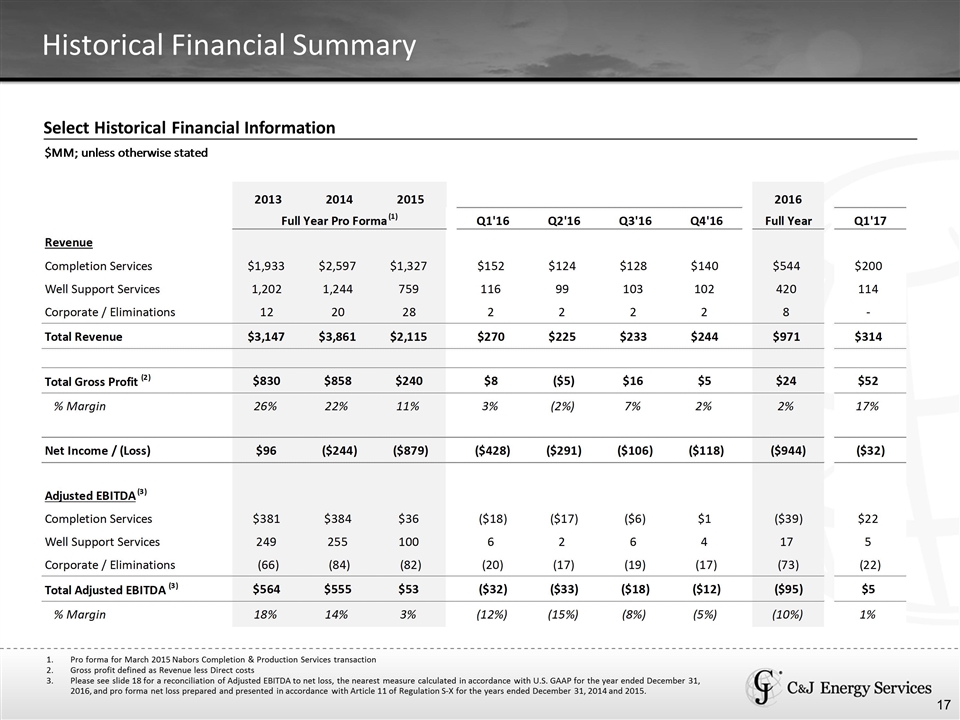
Select Historical Financial Information Historical Financial Summary Pro forma for March 2015 Nabors Completion & Production Services transaction Gross profit defined as Revenue less Direct costs Please see slide 18 for a reconciliation of Adjusted EBITDA to net loss, the nearest measure calculated in accordance with U.S. GAAP for the year ended December 31, 2016, and pro forma net loss prepared and presented in accordance with Article 11 of Regulation S-X for the years ended December 31, 2014 and 2015. 27
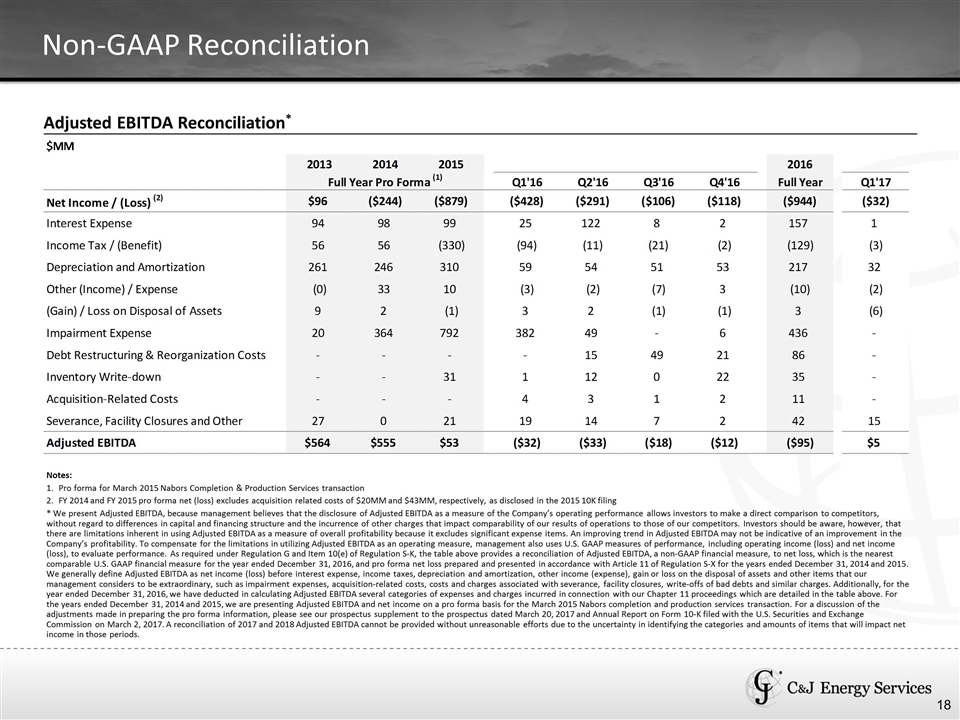
Adjusted EBITDA Reconciliation* Non-GAAP Reconciliation Notes: Pro forma for March 2015 Nabors Completion & Production Services transaction FY 2014 and FY 2015 pro forma net (loss) excludes acquisition related costs of $20MM and $43MM, respectively, as disclosed in the 2015 10K filing * We present Adjusted EBITDA, because management believes that the disclosure of Adjusted EBITDA as a measure of the Company’s operating performance allows investors to make a direct comparison to competitors, without regard to differences in capital and financing structure and the incurrence of other charges that impact comparability of our results of operations to those of our competitors. Investors should be aware, however, that there are limitations inherent in using Adjusted EBITDA as a measure of overall profitability because it excludes significant expense items. An improving trend in Adjusted EBITDA may not be indicative of an improvement in the Company’s profitability. To compensate for the limitations in utilizing Adjusted EBITDA as an operating measure, management also uses U.S. GAAP measures of performance, including operating income (loss) and net income (loss), to evaluate performance. As required under Regulation G and Item 10(e) of Regulation S-K, the table above provides a reconciliation of Adjusted EBITDA, a non-GAAP financial measure, to net loss, which is the nearest comparable U.S. GAAP financial measure for the year ended December 31, 2016, and pro forma net loss prepared and presented in accordance with Article 11 of Regulation S-X for the years ended December 31, 2014 and 2015. We generally define Adjusted EBITDA as net income (loss) before interest expense, income taxes, depreciation and amortization, other income (expense), gain or loss on the disposal of assets and other items that our management considers to be extraordinary, such as impairment expenses, acquisition-related costs, costs and charges associated with severance, facility closures, write-offs of bad debts and similar charges. Additionally, for the year ended December 31, 2016, we have deducted in calculating Adjusted EBITDA several categories of expenses and charges incurred in connection with our Chapter 11 proceedings which are detailed in the table above. For the years ended December 31, 2014 and 2015, we are presenting Adjusted EBITDA and net income on a pro forma basis for the March 2015 Nabors completion and production services transaction. For a discussion of the adjustments made in preparing the pro forma information, please see our prospectus supplement to the prospectus dated March 20, 2017 and Annual Report on Form 10-K filed with the U.S. Securities and Exchange Commission on March 2, 2017. A reconciliation of 2017 and 2018 Adjusted EBITDA cannot be provided without unreasonable efforts due to the uncertainty in identifying the categories and amounts of items that will impact net income in those periods. 28
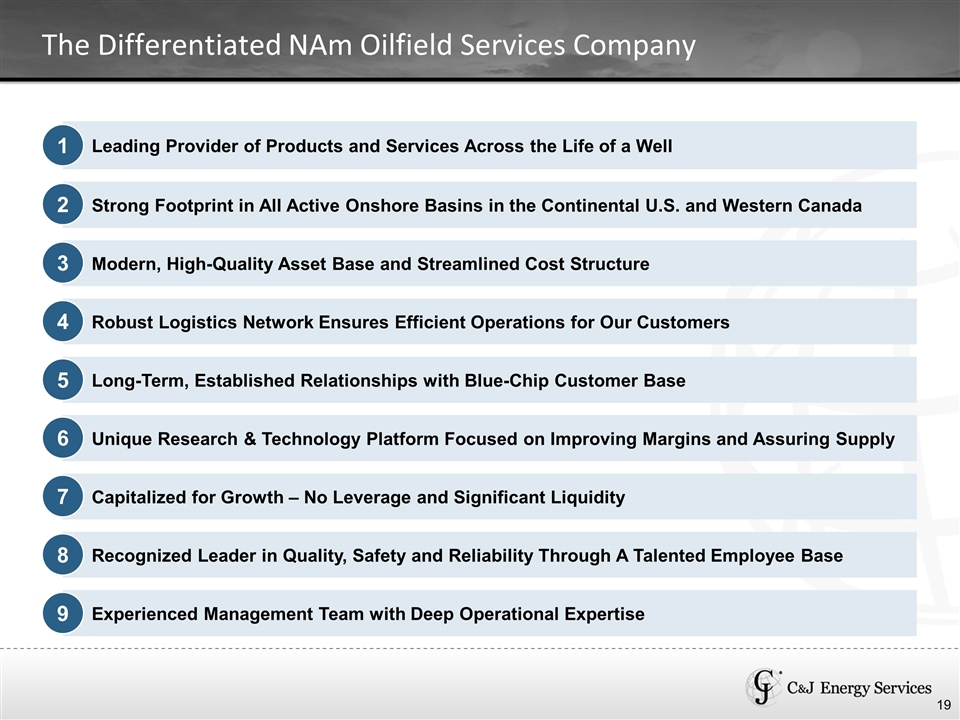
The Differentiated NAm Oilfield Services Company Leading Provider of Products and Services Across the Life of a Well Strong Footprint in All Active Onshore Basins in the Continental U.S. and Western Canada Modern, High-Quality Asset Base and Streamlined Cost Structure Robust Logistics Network Ensures Efficient Operations for Our Customers Long-Term, Established Relationships with Blue-Chip Customer Base Unique Research & Technology Platform Focused on Improving Margins and Assuring Supply Capitalized for Growth – No Leverage and Significant Liquidity Experienced Management Team with Deep Operational Expertise Recognized Leader in Quality, Safety and Reliability Through A Talented Employee Base 1 2 3 4 5 6 7 9 8 30
